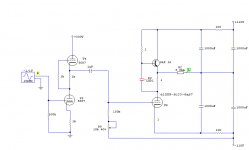Preamp section most likely yes...
Second, output section most likely not...how do you prevent DC on the output?
Second, output section most likely not...how do you prevent DC on the output?
Preamp section most likely yes...
Second, output section most likely not...how do you prevent DC on the output?
There is no DC path for current to flow through the speaker, if that is what you were questioning. But that is where the good news ends, it seems to me. The 1 ohm resistor between base and collector on the SAP 16 presumably means it is driven into more or less full conduction all the time. The whole output stage looks crazy. The two 100 ohm resistors may be useful to avoid damage to the tube until they, or something else, self -destructs. R9 seems to be a pointless "adjustment" that would have no meaningful effect. Definitely not something to try building, I would say!
The input stage is probably harmless, and indeed should work. It seems to be a typical "SRPP" that is actually not operating in PP mode at all, because it is driving into too high an impedance to be operating in the originally intended SRPP mode.
What are the parts's values?This way will work without exploding or pulling to one rail at start up.
What about David berning's ZOTL technology???
Tube amplifiers for high-end audio by The David Berning Company
Tube amplifiers for high-end audio by The David Berning Company
Same finality with different means, but streamlined and rationalized:What about David berning's ZOTL technology???
Tube amplifiers for high-end audio by The David Berning Company
http://www.diyaudio.com/forums/solid-state/235115-new-hybrid-concept-c-vac.html
What about David berning's ZOTL technology???
Tube amplifiers for high-end audio by The David Berning Company
Its a brilliant idea but not an OTL, just for the record.
In the output section we find an output transformer, something that normally OTLs are known as not having. In fact so much so that they are called output transformerless by name 😱
Admittedly, its an air core part, but nonetheless performs the task of matching impedance and in the process stepping it down.
Its a brilliant idea but not an OTL, just for the record.
In the output section we find an output transformer, something that normally OTLs are known as not having. In fact so much so that they are called output transformerless by name 😱
Admittedly, its an air core part, but nonetheless performs the task of matching impedance and in the process stepping it down.
I agree; I think it is misleading for Berning to associate the term "OTL" with his amplifiers, since they certainly do make use of transformers in the output stage, albeit high-frequency ones. It is also, I think, misleading when it is (sometimes) claimed that they are not hybrid amplifiers. It is absolutely clear that the current-carrying devices that directly control the current passing through the speakers are semiconductors.
I think the spirit of what Elvee is proposing is an interesting one. There have also been some articles by John Broskie in which he discusses circuits where semiconductors are used to boost the current-carrying capacity of vacuum tubes. (I vaguely recall that he had a discussion lf "super-triodes.")
Added: I just found one of his articles on this, SuperTriode.
Chris
Would that SuperTriode-Based Circlotron realy work?Added: I just found one of his articles on this, SuperTriode.
Would that SuperTriode-Based Circlotron realy work?
Probably yes, I think. Note, though, that John Broskie does caution about the DC coupling between the tubes and the MOSFETs, and what happens when the tubes have not yet warmed up, etc. It would be a good idea to test it cautiously, with a dummy load at first instead of a speaker! But as a general idea, it looks sound.
Chris
- Status
- Not open for further replies.
- Home
- Amplifiers
- Tubes / Valves
- Hybrid OTL amplifier


